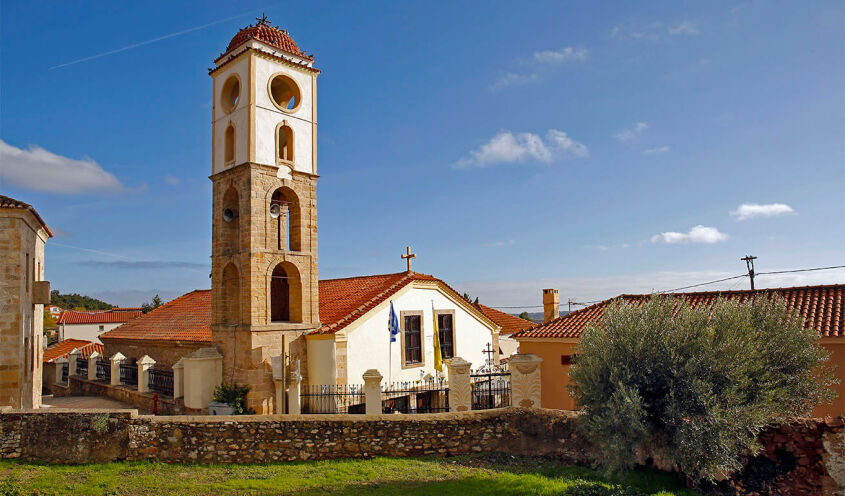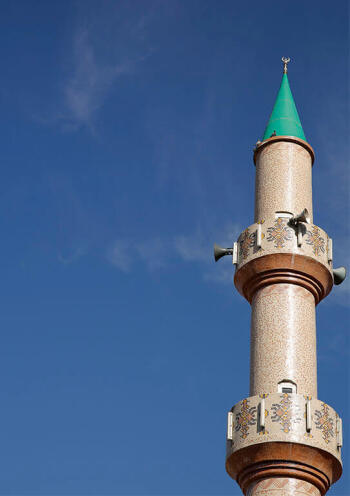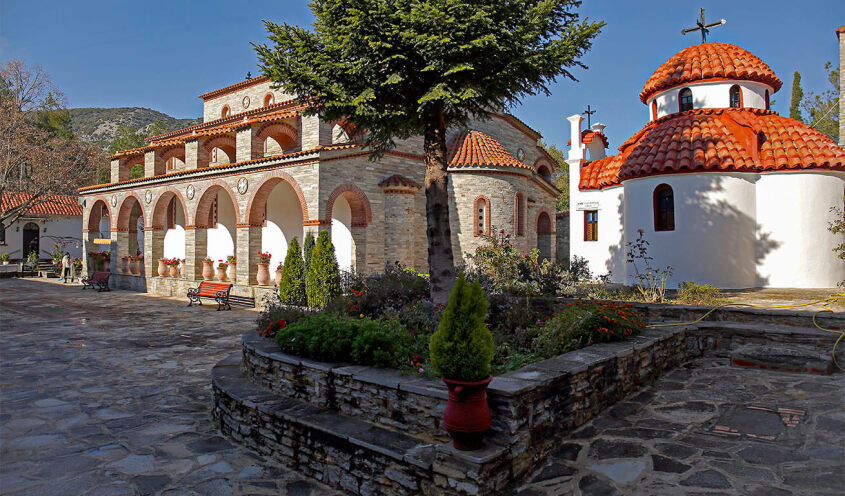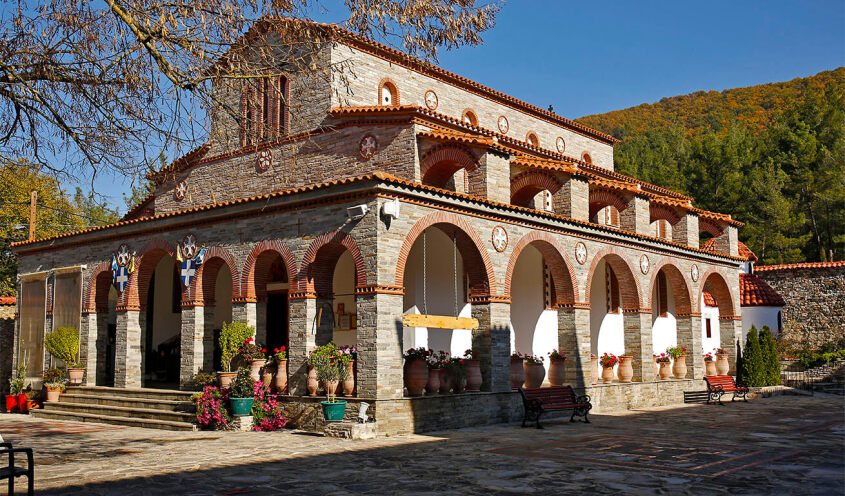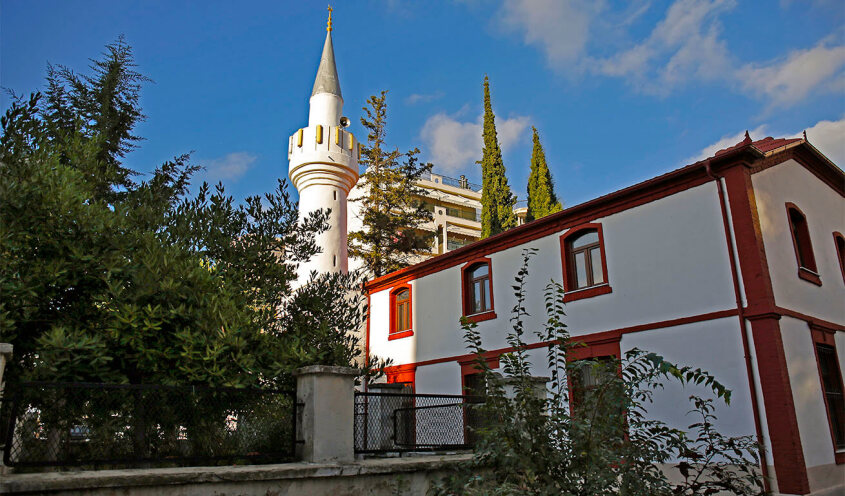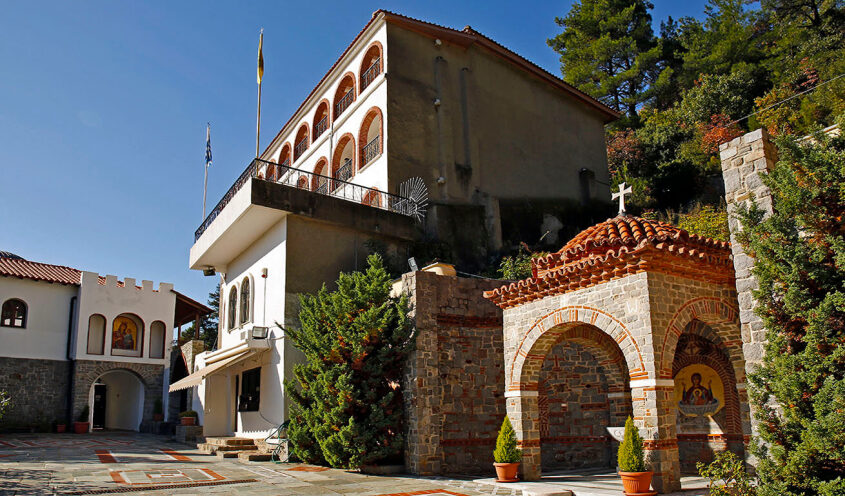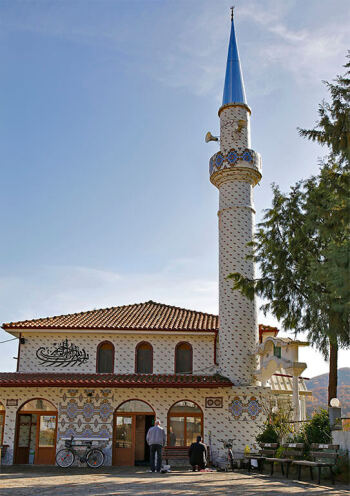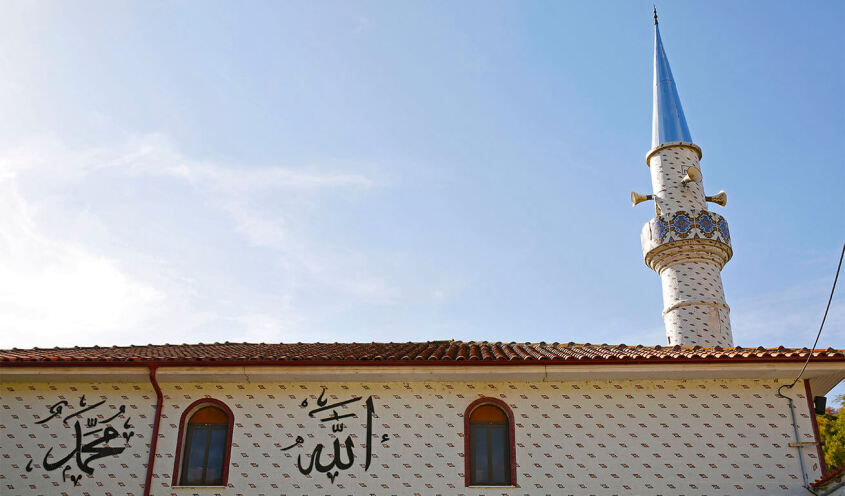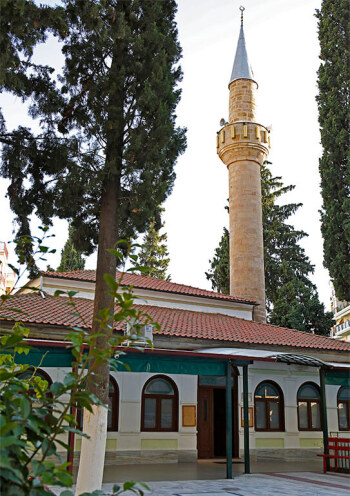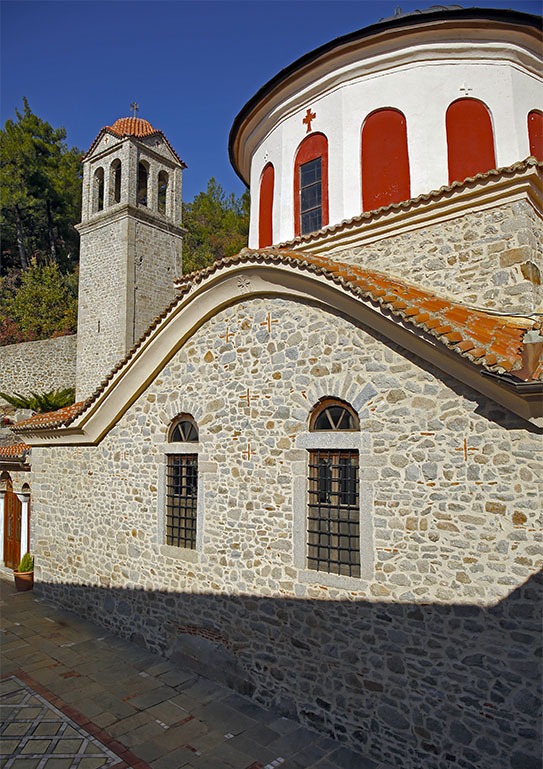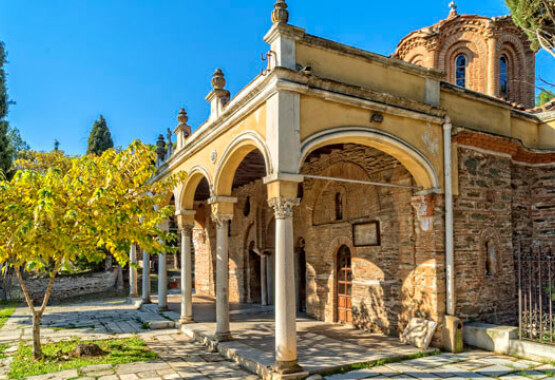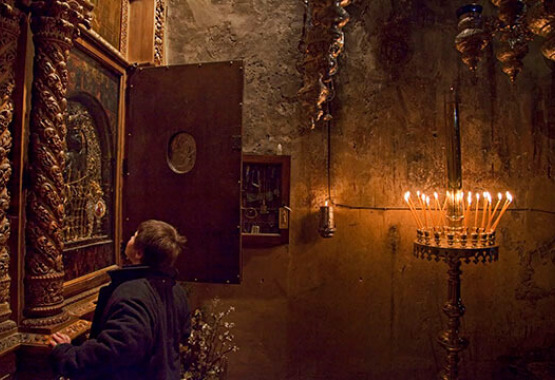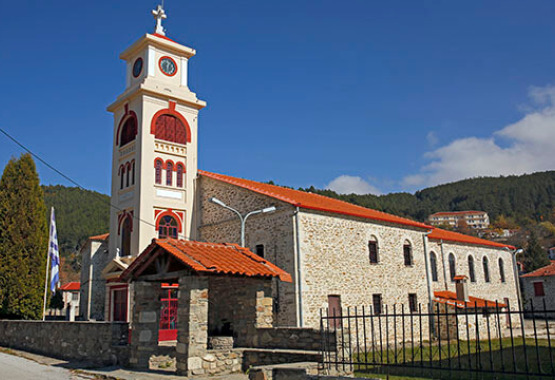
XANTHI
The Christian Monastery of Panagia Archangeliotissa is located on the hill overlooking the Samakov neighbourhood, in the northeast part of the town, and it offers a fine view of it as well as of the plain. The building was constructed after the 1829 earthquakes, on the site of an older monastery which apparently existed in the 16th century and probably earlier than that. It is a pilgrimage site for the Thracian people (the inhabitants of the region of Thrace), and it is particularly visited on the Feast Days of the Virgin Mary on August 15th and on November 21st. The Monastery also houses the Ecclesiastical Museum of the Xanthi and Peritheorio Ecclesiastical Province (called Metropolis).
The Convent of Panagia Kalamou was built on a beautiful location, not far from Panagia Archangeliotissa Monastery. According to tradition, the name “Kalamou” comes from the word “kalamies”, as the icon of the Virgin Mary (Panagia) was found by the banks of the nearby Kosynthos River, among the reeds [kalamia in Greek]. The founding of the convent appears to go back to the 12th century; still, there are only fragments of evidence, as the bouts of destruction and plundering over the centuries have resulted in the loss of precious heritage items and archives. The nunnery began to take its present-day shape in the late 19th century; but most of the buildings are much younger, such as the Katholikon [main church] which was completed in 1965. Two 15th century icons are preserved there; the icons of Panagia Kalamiotissa and of the Dormition of the Mother of God.
The Monastery of the Holy Archangels is located on the hill which is crowned by the Byzantine Castle. The katholikon and the murals inside it date back to the 16th century, but not much else is known about the history of the monastery. The nearby religious buildings such as the guest sleeping quarters and the Ecclesiastical School of Xanthi are much younger.
The Cathedral Church of St. John the Baptist is located in the heart of the Old Town of Xanthi. It was built after the 1829 earthquakes, on the ruins of an older church dating probably to the 16th century. It is a church with two side chapels built in the style of a three-aisled basilica; the central aisle is dedicated to St John the Baptist, and the other two were named in honour of the Annunciation to the Mother of God and of St. George of Ioannina. All the old churches of the town were built around that time, such as the Archangels Church in Kavaki, St. George’s, St. Vlasios and the Akathist Hymn Churches.
The Monastery of St. Nicholas in Porto Lagos is a dependency of the Vatopedi Monastery on Mount Athos. It was built on an islet within Lake Vistonida, and access to it is possible via a wooden bridge which connects it with the land and the Xanthi - Komotini National Road. The breathtaking landscapes, and the long history of the monastery which goes back to the times of the Byzantine Empire, as well as the churches of St. Nicholas and Pantanassa (Our Lady) attract large numbers of visitors and pilgrims, particularly during the summer.
In Avdira, the historic Agia Paraskevi Church was built in 1845, following the destruction of the previous church during the 1829 earthquakes. Inside it, several beautiful murals have been preserved, and the icons of Christ date to the 18th and 19th century.
The Achrian Mosque in the Old Town of Xanthi, known also as the mosque of the Pomakoi people, is the oldest in town, as it was built during the second half of the 16th century. Tsinar Mosque on Miaouli Street was built two centuries later, and it was named for the cypress trees on its entrance; its marble minaret is quite impressive. Servili Mosque on Skra Street shares a number of architectural features with the 19th century Tobacco Warehouses, and Mouhatzir Mosque in the like-named neighbourhood, on Doiranis Street, has several baroque-style decorative elements on its entrance.
Kassaba Mosque in Genisea is no longer in use. It’s a very impressive building, with its high minaret built with local hewn stones, and its beautiful architectural features closely resembling the style of the neighbouring tobacco warehouses. The nearby Moustafa Pasa Mosque is still in use; it is smaller than Kassaba Mosque and elegantly built according to the late Ottoman architecture. The Kioutouklou Baba Tekke, near Selino village, is visitable and easily accessible. The only well-preserved part of it is the tomb section of the monastery, which used to be the worship area of the members of the Bektasides Order until the early 20th century.
Across the Pomakochoria (villages of the Pomakoi) there are well-tended mosques (most Pomakoi people are Sunni Muslems), and the exterior walls in some of them are clad with ceramic tiles, such as Melivoia Mosque, or the minaret of Glafki Mosque.
Religious Monuments in Xanthi
Christian and Muslim monuments side by side
For hundreds of years, Christian monasteries and churches have coexisted with mosques and Muslim monasteries (tekke) in the area of Xanthi, shaping an important aspect of the town’s multicultural identity.The Christian Monastery of Panagia Archangeliotissa is located on the hill overlooking the Samakov neighbourhood, in the northeast part of the town, and it offers a fine view of it as well as of the plain. The building was constructed after the 1829 earthquakes, on the site of an older monastery which apparently existed in the 16th century and probably earlier than that. It is a pilgrimage site for the Thracian people (the inhabitants of the region of Thrace), and it is particularly visited on the Feast Days of the Virgin Mary on August 15th and on November 21st. The Monastery also houses the Ecclesiastical Museum of the Xanthi and Peritheorio Ecclesiastical Province (called Metropolis).
The Convent of Panagia Kalamou was built on a beautiful location, not far from Panagia Archangeliotissa Monastery. According to tradition, the name “Kalamou” comes from the word “kalamies”, as the icon of the Virgin Mary (Panagia) was found by the banks of the nearby Kosynthos River, among the reeds [kalamia in Greek]. The founding of the convent appears to go back to the 12th century; still, there are only fragments of evidence, as the bouts of destruction and plundering over the centuries have resulted in the loss of precious heritage items and archives. The nunnery began to take its present-day shape in the late 19th century; but most of the buildings are much younger, such as the Katholikon [main church] which was completed in 1965. Two 15th century icons are preserved there; the icons of Panagia Kalamiotissa and of the Dormition of the Mother of God.
The Monastery of the Holy Archangels is located on the hill which is crowned by the Byzantine Castle. The katholikon and the murals inside it date back to the 16th century, but not much else is known about the history of the monastery. The nearby religious buildings such as the guest sleeping quarters and the Ecclesiastical School of Xanthi are much younger.
The Cathedral Church of St. John the Baptist is located in the heart of the Old Town of Xanthi. It was built after the 1829 earthquakes, on the ruins of an older church dating probably to the 16th century. It is a church with two side chapels built in the style of a three-aisled basilica; the central aisle is dedicated to St John the Baptist, and the other two were named in honour of the Annunciation to the Mother of God and of St. George of Ioannina. All the old churches of the town were built around that time, such as the Archangels Church in Kavaki, St. George’s, St. Vlasios and the Akathist Hymn Churches.
The Monastery of St. Nicholas in Porto Lagos is a dependency of the Vatopedi Monastery on Mount Athos. It was built on an islet within Lake Vistonida, and access to it is possible via a wooden bridge which connects it with the land and the Xanthi - Komotini National Road. The breathtaking landscapes, and the long history of the monastery which goes back to the times of the Byzantine Empire, as well as the churches of St. Nicholas and Pantanassa (Our Lady) attract large numbers of visitors and pilgrims, particularly during the summer.
In Avdira, the historic Agia Paraskevi Church was built in 1845, following the destruction of the previous church during the 1829 earthquakes. Inside it, several beautiful murals have been preserved, and the icons of Christ date to the 18th and 19th century.
The Achrian Mosque in the Old Town of Xanthi, known also as the mosque of the Pomakoi people, is the oldest in town, as it was built during the second half of the 16th century. Tsinar Mosque on Miaouli Street was built two centuries later, and it was named for the cypress trees on its entrance; its marble minaret is quite impressive. Servili Mosque on Skra Street shares a number of architectural features with the 19th century Tobacco Warehouses, and Mouhatzir Mosque in the like-named neighbourhood, on Doiranis Street, has several baroque-style decorative elements on its entrance.
Kassaba Mosque in Genisea is no longer in use. It’s a very impressive building, with its high minaret built with local hewn stones, and its beautiful architectural features closely resembling the style of the neighbouring tobacco warehouses. The nearby Moustafa Pasa Mosque is still in use; it is smaller than Kassaba Mosque and elegantly built according to the late Ottoman architecture. The Kioutouklou Baba Tekke, near Selino village, is visitable and easily accessible. The only well-preserved part of it is the tomb section of the monastery, which used to be the worship area of the members of the Bektasides Order until the early 20th century.
Across the Pomakochoria (villages of the Pomakoi) there are well-tended mosques (most Pomakoi people are Sunni Muslems), and the exterior walls in some of them are clad with ceramic tiles, such as Melivoia Mosque, or the minaret of Glafki Mosque.
